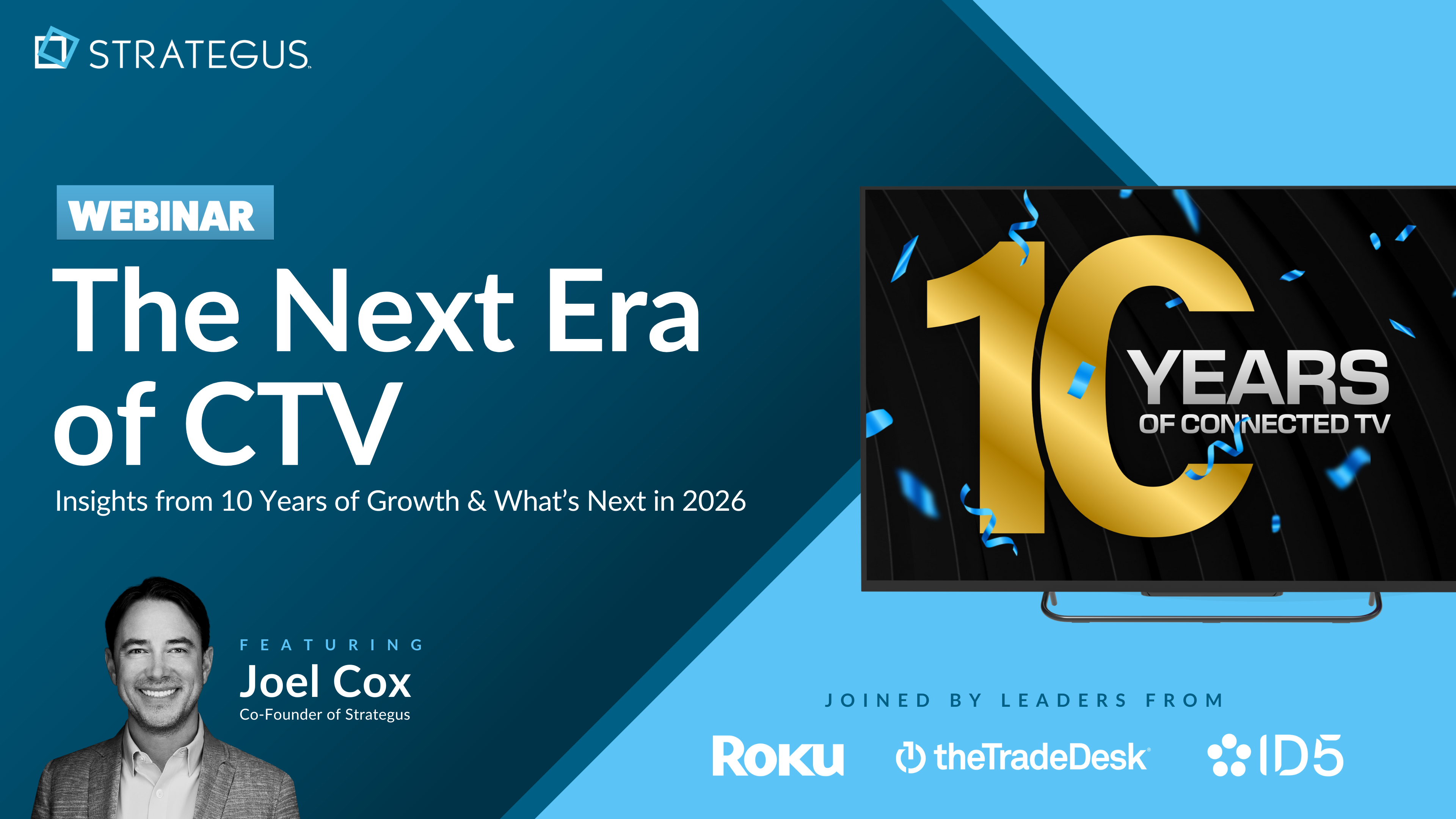- Home
- Strategus Blog
- Performance TV Advertising: How to Drive Real Results with CTV
Performance TV Advertising: How to Drive Real Results with CTV
 Traci Ruether
Traci Ruether
13 minutes read

Performance advertising is all about outcomes: leads, sales, foot traffic, and clear ROI. What started with pay-per-click (PPC) campaigns has now expanded into every channel that can prove its value, including TV.
Thanks to programmatic connected TV (CTV), television is no longer just a branding tool. It’s now a performance channel– driven by targeting, personalization, and real-time attribution.
But to make it work, you need a new approach. This guide covers everything you need to launch high-performing CTV campaigns, from setting goals and KPIs to optimizing for measurable results.
What Is Performance TV?
Performance TV is a form of TV advertising that’s built to drive real, trackable results– not just brand awareness. It uses programmatic CTV to target specific audiences, track actions, and measure outcomes.
Think of it like the modern version of old-school infomercials with a clear call to action and an urge to respond. But now, advertisers can go much further with precise targeting, personalized messaging, cross-device retargeting, and detailed reporting.
How to Use CTV as a Performance Channel
To transform CTV into a performance marketing channel, marketers must use all the capabilities available in a strategic and goal-oriented manner.
As such, three things underpin performance TV success:
- Precise targeting
- Full-funnel retargeting
- Robust attribution and measurement
Let’s take a look at each in detail:
1. Precise Targeting
When running programmatic CTV campaigns, marketers can target specific audience segments. This replaces the spray-and-pray approach of linear TV with a much more precise strategy.
In this way, CTV allows brands to reach the right people, at the right time, with the right message by customizing their creative based on which customer segments are being targeted.
2. Full-funnel Retargeting
It’s rare that someone purchases a product or service directly after seeing an ad on their television. That’s why CTV ads should be used as an initial touchpoint in cross-device campaigns. The average household now has 16 connected devices.
And because it can take seven or more exposures to a brand before customers are ready to buy, integrating all of these devices into a cohesive strategy is key to converting prospects.
3. Robust Attribution and Measurement
Performance marketing hinges on measurability. While it’s all good and fine to cross your fingers that a billboard will drive visits to your store, actual results will remain an unproven assumption without the hard data.
Luckily, CTV delivers the deterministic data required to link ad exposures to real outcomes, eliminating the guesswork.
Strategus Co-Founder and EVP of Innovation Joel Cox explains:
How to Target Connected TV Audiences
CTV targeting will vary depending on what your ad tech stack looks like. Some DSPs still use rather fundamental data sources to build generic segments. Other CTV platforms provide more precise audience building tools, but they limit marketers to a single walled garden.
At Strategus, though, we take a layered approach to targeting that incorporates multiple data sources to maximize results. Rather than providing off-the-shelf audience segments, we work with agencies and brands to build custom audiences based on a mix of tactics.
Our targeting methods include:
- Website retargeting: Reengage warm leads on the big screen and lure online shoppers back to their abandoned carts. This keeps your brand top of mind after leads step away from the computer.
- First-party data: Leverage customer data from your CRM to deliver personalized CTV ads directly to your contacts’ living rooms.
- Lookalike modeling: Expand your reach by building custom lookalike audiences. This powerful tactic is our second-best performer for driving results.
- Location-based retargeting: Reconnect with users who‘ve visited your stores — or conquest foot traffic from competitor locations. Both are powerful tactics to translate physical touchpoints into digital engagement.
- Smart audience contextual: Reach consumers actively researching your services by targeting viewers based on the websites they’ve been visiting and keywords they’ve been typing into Google.
- ACR data targeting: Reach specific households based on their TV viewing habits and interests for precise audience alignment. This could mean showing an ad for a Lexus convertible on its way to a golf course to a viewer who regularly watches live golf.
- Linear TV extension: Bridge the gap between your linear TV campaigns and CTV by targeting households exposed to your TV ads for increased reach and frequency. A combination of both mediums ensures that your efforts aren’t siloed.
- Amazon data targeting: Leverage Amazon purchase data to reach consumers actively shopping for products related to your campaign. For instance, a person who often purchases gluten-free products may see a commercial for a local health store.
CTV is thus a more premium subset of OTT that focuses on big-screen TVs where co-viewing is more common (resulting in more ad impressions) and viewers are more engaged.
How to Integrate CTV Into a Full-Funnel Campaign
Running ads on the big screen is powerful, but it’s not enough on its own. People usually don’t take action while watching TV, so you need to follow up on other devices like phones, tablets, and laptops.
Here’s how to do it:
- Start with a strong CTV ad to build awareness and introduce your offer on living room screens.
- Use CTV retargeting to reach the same viewers again on clickable platforms like YouTube, Instagram, or display ads.
- Adjust the message as you move down the funnel—remind, persuade, and drive action with each touchpoint.
- Track engagement and conversions to see which devices and messages lead to results.
This multi-touch strategy drives more action. In fact, we’ve seen a 200% boost in conversions when retargeting is added to CTV campaigns.
Performance TV Metrics You Should Track
By definition, performance TV requires access to robust data about campaign performance. Impressions, completions, conversions, and clicks should all be tracked.
Monitoring these is essential for several reasons. For one, keeping an eye on this data ensures brand safety and viewability. It also helps advertisers gain insight into audience engagement and identify opportunities for improvement.
Here’s a look at the most common CTV metrics and how they might inform your approach.
- Impressions: This metric tells you how many people saw at least a portion of your CTV ad. Although it’s more of a vanity metric in that it doesn’t quantify revenue, it still sheds light into the reach of a given campaign.
- Completion rate: Video completion rate is often high in CTV advertising because the ads are non-skippable and play within user-selected content. For this reason, VCR is more useful for detecting major trends that would indicate an issue, as well as for monitoring completion rates across other streamable channels like online video and streaming audio.
- Clicks: When running omnichannel CTV campaigns that use retargeting tactics across clickable media like search, display, online video, and more, you’ll want to measure how many clicks are generated. This is a straightforward count of the number of times users clicked on your ads to learn more.
- Click-Through Rate (CTR): Click-through rate measures the number of clicks per impression. While the CTR will generally be low, any increase indicates that your efforts are resonating with viewers and driving action.
This metric should always be considered in terms of the goal and channel. An awareness ad won’t have a high click-through rate, nor will a CTV ad that lacks clickable elements.
- Conversions: This metric focuses on the specific actions taken by viewers as a direct result of seeing your CTV advertisement. Depending on your campaign, a conversion might mean that the viewer filled out a contact form, made an online purchase, or stepped foot into brick-and-mortar locations.
- Conversion rate: Conversion rate measures the percentage of users who’ve completed a desired action by dividing conversions by impressions. These actions are tied directly to attribution capabilities, which is why we dive deeper into attribution below.
Learn more about CTV reporting →
How to Use Advanced Attribution to Track Real Results from CTV
CTV ads rarely lead to instant conversions. That’s why measuring success means tracking what people do after they see your ad, across both digital and real-world touchpoints.
With advanced attribution and multi-touch tracking, you can connect the dots between ad views and actual business outcomes like sales, visits, and website activity. This gives you a clear view of return on ad spend (ROAS).
Here’s what you can measure with advanced CTV attribution:
- Website visits after viewing ads: Track how many people visit your site after seeing your CTV ad. Understand which campaigns drive online traffic.
- In-store visits (foot traffic): Use GPS data to measure how many viewers visited your physical location after ad exposure.
- Online purchases: See the full customer path from ad view to online checkout. Link revenue directly to your CTV campaign.
- CPG sales (SKU-level): For consumer goods, match in-store purchases to ad exposure using SKU-level data for better offline attribution.
- Match with first-party data: Combine your customer data with ad exposure data to measure how CTV impacts both new and existing customers.
- Track revenue with a pixel: Add a revenue pixel to your site to capture the exact dollar value of purchases tied to your CTV ads.
- Impact on search and social: Measure how CTV boosts performance on other channels like Google Search and Instagram. Understand its influence across the full funnel.
With these tools, you can prove the real value of your CTV campaigns and confidently optimize for performance.
Learn more about CTV reporting →
Programmatic TV Advertising Pro Tips
Once you have the capabilities for targeting, retargeting, and attribution squared away, the final step is taking a strategic approach focused on business outcomes. This means aligning your CTV campaigns with specific, measurable goals, and continuously optimizing your approach based on the data.
- Define campaign goals and target audiences: The first step to crafting a CTV campaign is defining your goals (e.g., brand awareness, website visits, foot traffic to a brick-and-mortar location) and target audience segments. This will lay a foundation for more targeted and actionable campaigns.
- Gather existing video assets: Next, assess your existing video library. Look for high-quality, on-brand content that aligns with CTV's technical requirements. This includes professional production value, clear branding throughout, a singular focus on a key message, and clean design with easy-to-read text and contrasting colors for optimal viewing on large screens.
- Update what you have or build CTV-first creative: Whether you’re updating existing video assets or creating new ads from scratch, it’s all about giving users a clear call to action based on your campaign goals. Some tactics for doing this include promoting current deals, showcasing your current inventory with dynamic creative, or incorporating interactive elements like QR codes that drive action.
- Personalize messaging to different audiences: The key to CTV advertising is delivering relevant ads that resonate with viewers. As such, tailoring ad creative to different buyers drives better results. This could mean swapping out the B-roll or highlighting different products and services.
- Nail the basic requirements and specs: Align with technical specs for the length (15 or 30 seconds), file format (MP4), and resolution (1080 p). Failure to meet these specs can cause latency and buffering, potentially causing viewers to abandon the app or even reboot their devices.
- Put guardrails in place to prevent ad fatigue: Rotate at least 3 creative variations can help prevent ad fatigue, as well as refreshing your ads quarterly. You’ll also want to monitor campaign frequency and engagement to adjust your strategy based on what the data shows.
- Integrate your CTV ads into full-funnel campaigns: Expand your reach and boost conversions by layering retargeting efforts across various channels like display ads, paid social media ads, and paid search ads. This allows you to deliver targeted messages throughout the customer journey, from initial brand awareness to website visits and ultimately, conversions.
- Test and optimize campaigns in flight: Just like other digital channels, programmatic CTV campaigns should be monitored and optimized on an ongoing basis.
Why Choose Strategus as Your Performance TV Partner
Performance TV advertising isn’t rocket science, but navigating its complexities requires expertise and a deep understanding of the CTV landscape. That's where Strategus comes in.
As the first agency to run a programmatic CTV ad in 2015, we have the experience and technology to help you achieve your performance goals.
We offer:
- Unmatched expertise: Our team of CTV specialists will guide you through every step of the process, from strategy development to campaign execution and optimization.
- Full-funnel retargeting: Extend your reach and maximize conversions with cross-device retargeting strategies that engage viewers across all their connected devices.
- Advanced targeting & attribution: Our ecosystem of 200+ data providers ensures targeting and attribution like never before, enabling us to develop informed strategies and adapt on the fly based on what the data reveals.
- Transparent reporting: Gain clear insights into campaign performance with our comprehensive reporting dashboards and custom analytics.
With Strategus as your partner, you get the broad reach, data integrations, and expertise required to drive CTV results. Our combination of premium inventory and data-driven targeting ensures precise ad placement focused on your viewers, thus maximizing campaign results.
Ready to transform your TV advertising into a performance powerhouse?
Contact us today and let us help you achieve your business goals with Performance TV.
Frequently Asked Questions
What Is Performance TV?
Performance TV uses programmatic CTV to drive measurable outcomes like leads, purchases, and website visits. Unlike traditional TV ads that focus on awareness, performance TV campaigns include audience targeting, retargeting, and attribution to track real results across connected devices.
How Do I Create a Performance TV Ad?
Start with clear goals and define your target audience. Use high-quality video assets with a strong call to action. Align the creative with your campaign objectives and platform specs. Then personalize your message for each audience segment and integrate it into a cross-device retargeting strategy.
How Can I Measure Advertising Performance on TV?
Use CTV attribution tools to track metrics like impressions, website visits, conversions, and in-store foot traffic. Add pixels to measure revenue and online purchases. Monitor search lift, cross-device behavior, and campaign-level performance through connected DSPs and analytics dashboards.
What Is Performance Advertising?
Performance advertising focuses on measurable outcomes like sales, signups, or clicks. It uses targeting, retargeting, and attribution to track return on ad spend. Unlike traditional advertising, performance campaigns let you optimize in real time based on what drives the most conversions.
What Are Performance Marketing Channels?
Performance marketing channels include paid search, social media, email, display ads, and now connected TV. These channels allow advertisers to track user actions and measure ROI. Each platform offers real-time reporting so you can adjust campaigns based on performance data.
What Is Programmatic TV Advertising?
Programmatic TV advertising automates the buying of ad slots on streaming platforms and connected TVs. It uses audience data and real-time bidding to serve ads to specific viewers. This approach improves efficiency, targeting, and performance tracking across devices and platforms.
Does the Style of Your TV Campaign Matter?
Yes, the creative style directly affects performance. Viewers respond better to ads with clear messages, strong calls to action, and content tailored to their interests. High-quality visuals, concise scripts, and engaging storytelling help your ads stand out on large living room screens.
How to Evaluate TV Advertising?
Evaluate TV ads using metrics like impressions, video completion rate, click-through rate, and conversions. Use attribution tools to track site visits, purchases, and foot traffic after ad exposure. Look at performance by audience segment and platform to refine your strategy.
How Will I Track My TV Advertising?
Track CTV campaigns with pixels, device-level reporting, and first-party data integration. Use multi-touch attribution to connect ad views with site visits, sales, and other actions. DSPs and managed service partners like Strategus provide dashboards with real-time insights and performance breakdowns.
Can You Recommend Some TV Advertising Platforms That Provide the Best Performance TV Capabilities?
Yes. Top platforms for performance TV include:
- Strategus: Offers full-funnel retargeting, Amazon data targeting, and advanced attribution. Best for managed campaigns with hands-on support.
- The Trade Desk: Provides broad reach and granular targeting across the open internet. Requires experience with programmatic buying.
- Roku OneView: Integrates directly with Roku inventory. Strong for household targeting but limited to Roku's ecosystem.
- Amazon DSP: Ideal for shopper-based targeting using first-party data. Offers deep insights but can be complex to operate.
Each platform supports measurable outcomes but varies in usability, data access, and campaign control. Choose based on your goals and internal capabilities.

Traci Ruether is a content marketing consultant specializing in video tech. With over a decade of experience leading content strategy, she takes a metrics-driven approach to storytelling that drives traffic to her clients' websites. Follow her on LinkedIn at linkedin.com/in/traci-ruether or learn more at traciruether.com.
Strategus is a managed services connected TV(CTV) advertising agency with over 60,000+ campaigns delivered. Find out how our experts can extend your team and drive the result that matter most.
Talk to an Expert
Table of Contents
- What Is Performance TV?
- How to Use CTV as a Performance Channel
- How Connected TV Audiences Are Targeted
- Integrating CTV into Full-Funnel Campaigns
- Performance Metrics to Track
- Using Advanced Attribution to Measure Tangible Results
- Programmatic TV Best Practices
- Why Choose Strategus as Your Performance TV Partner
Seeking a Custom CTV Strategy That Delivers?
What to read next
App Event Tracking: Tie Mobile App Activity to CTV Campaigns
Let’s say you’re running a CTV campaign for a personal finance app.
5 minutes read

Stop Guessing Who Your Audience Is — Let Their Apps Tell You
Connected TV (CTV) targeting often falls in one of two camps.
8 minutes read
See Who Bought After Your Ad + How Much They Spent
You can’t improve what you can’t measure. And for years, that’s been a major problem with TV advertising.
4 minutes read

First-Party Attribution: Match Ads to Sales With CRM Data
The value of first-party data continues to grow.
7 minutes read













